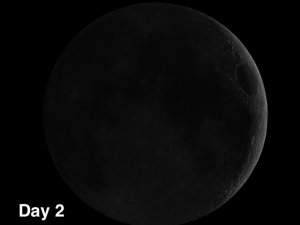The week of May 18-24 takes us from Lunar Day 26 to Day 2. This is not a good week for lunar observing, as the Moon is so close to the Sun (new moon is on Friday) but this week we will try to spot the earliest Moon with the naked eye.
 Because the Moon is so very low on the horizon, looking for actual features on Days 1 and 2 is really not worth the trouble. However, some astronomers play a game of trying to spot the earliest possible Moon with the naked eye. After the Sun has set on Saturday and Sunday and twilight has begun, check out the area around the sunset point on the horizon for the Moon. If you don’t have any luck, scan the area with binoculars and if you can see a thin crescent try it with your naked eyes. Do not attempt this with binoculars until the Sun has completely set. Permanent eye damage will result if you accidentally view the sun through binoculars!
Because the Moon is so very low on the horizon, looking for actual features on Days 1 and 2 is really not worth the trouble. However, some astronomers play a game of trying to spot the earliest possible Moon with the naked eye. After the Sun has set on Saturday and Sunday and twilight has begun, check out the area around the sunset point on the horizon for the Moon. If you don’t have any luck, scan the area with binoculars and if you can see a thin crescent try it with your naked eyes. Do not attempt this with binoculars until the Sun has completely set. Permanent eye damage will result if you accidentally view the sun through binoculars!
OF ADDITIONAL INTEREST ON THE MOON:
Early Tuesday morning the Moon will be just 4° below Comet 58P Jackson-Neujman.
Because the comet is only at magnitude +10.5, you will need a telescope to see it.
======================
It is highly recommended that you get a copy of Sky and Telescope’s Field Map of the Moon, the very finest Moon map available for use at the telescope. It is available for $10.95 at www.skyandtelescope.com and on Amazon. All features mentioned in this blog will be keyed to the grid on the Field Map and will look like this: Plato: [NW/D9]
Credits:
Courtesy of Gray Photography of Corpus Christi, Texas
Lunar photos: NASA / USGS / BMDO / LROC / ASU / DLR / LOLA / Moon Globe. Used by permission
- Rupes Cauchy: A Best Known Fault on the Moon - July 22, 2024
- Moon Crater Schickard – Crater Floor has Stripes - July 15, 2024
- Moon Craters Langrenus and Vandelinus - July 8, 2024